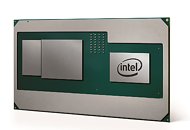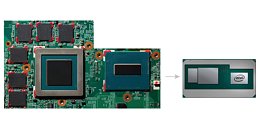Monday, November 6th 2017

Intel Announces "Coffee Lake" + AMD "Vega" Multi-chip Modules
Rumors of the unthinkable silicon collaboration between Intel and AMD are true, as Intel announced its first multi-chip module (MCM), which combines a 14 nm Core "Coffee Lake-H" CPU die, with a specialized 14 nm GPU die by AMD, based on the "Vega" architecture. This GPU die has its own HBM2 memory stack over a 1024-bit wide memory bus. Unlike on the AMD "Vega 10" and "Fiji" MCMs, in which a silicon interposer is used to connect the GPU die to the memory stacks, Intel deployed the Embedded Multi-Die Interconnect Bridge (EMIB), a high-density substrate-level wiring. The CPU and GPU dies talk to each other over PCI-Express gen 3.0, wired through the package substrate.
This multi-chip module, with a tiny Z-height, significantly reduces the board footprint of the CPU + discrete graphics implementation, when compared to having separate CPU and GPU packages with the GPU having discrete GDDR memory chips, and enables a new breed of ultra portable notebooks that pack a solid graphics muscle. The MCM should enable devices as thin as 11 mm. The specifications of the CPU and dGPU dies remain under the wraps. The first devices with these MCMs will launch by Q1 2018.A video presentation follows.
This multi-chip module, with a tiny Z-height, significantly reduces the board footprint of the CPU + discrete graphics implementation, when compared to having separate CPU and GPU packages with the GPU having discrete GDDR memory chips, and enables a new breed of ultra portable notebooks that pack a solid graphics muscle. The MCM should enable devices as thin as 11 mm. The specifications of the CPU and dGPU dies remain under the wraps. The first devices with these MCMs will launch by Q1 2018.A video presentation follows.


51 Comments on Intel Announces "Coffee Lake" + AMD "Vega" Multi-chip Modules
A future AMD APU using HBM
couldwill be a real monster.The rumors were indeed true.
I think ryzen mobile really will kill it below 30 W but I don't see any product that will be that much better than intel's cpu when you add in the dedicated gpu.
Either way, good news for AMD.
I bet that OEMs explained to AMD that no matter how good Ryzen might be, it wouldn't get in many laptops for various reasons.
Intel needs a strong AMD as a shield against a huge Nvidia and AMD needs money and a bigger market share for it's GCN and FreeSync products.
The news article even explains how this works, so I'm very perplexed at how you came to this conclusion...
Well anyways, HBM 1 = 128 gb/sec, HBM 2 = 240 gb/sec ~
More than sufficient for laptops and HBM is power efficient and judging by ryzen mobile the vega chips can be very power efficient.
Ryzen mobile still stands to capture tons of sub 30w systems.
It is also a way for Intel to offer Apple a more appealing graphics solution until Apple decides to make their own "PC" CPU and dump Intel in the same way they dumped Imagination.
Finally it also explains why Apple doesn't have any notebook refreshes this year, as they were waiting for this.
They both denied it was licensing... so it was surmised it has to be a full chip. Tada.